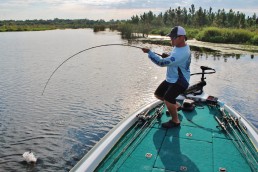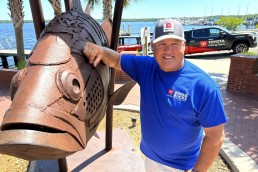Cut ’em No Slack
Courtesy of Vance McCullough
“It felt like I was in a crash three times,” said my son, Hunter, telling me how a guy tried to snatch his truck out of a deep mudhole along the St. Mary’s River that separates our fair state from Georgia. On the 3rd attempt the guy broke his own tow hitch. Not the bolts that hold it onto the truck. Not the pin in the receiver. The hitch itself cracked and fractured. The manufacturer said they had never seen such. It also tore up my son’s 25-year-old F-150. Two life lessons here: 1) this is why you don’t give a teenager a brand spanking new truck to learn on (because at some point, he’s going to confuse that thing with a boat) and 2) throwing slack in your line and snatching it beyond tight will eventually break something.
It’s the same when setting the hook in heavy cover with strong line and a big rod.
I am often amazed at comments from those who say they frequently bend-out flipping hooks on big bass. It is critically important to match your gear – rod, line and hook must compliment one another. 80-lb braid and 14-fluoro call for different rod actions and will also dictate the minimum and maximum wire diameters that will penetrate without flexing too much.
But you already knew that.
One aspect where many anglers miss it (literally) is hook-setting technique.
“A lot of anglers that go an hour without a bite, the first thing they do when they get a bite is they drop their rod tip and get slack in their line and that’s definitely not what you want, especially with braid,” noted Randall Tharp as I picked his brain on the subject years ago. “A bass that really wants that bait is not gonna turn it loose. Every bite is different but basically you want to reel down, take every bit of slack out of that line and then jack him. You don’t want to drop that rod tip and create slack.”
Tharp explained that when an angler drops the rod tip immediately before setting the hook, he creates slack in the line at two critical moments – just before and just after hook penetration because the impact is so violent that it pulls the fish toward said angler and creates a slack line at the moment when an angler needs to get the fish’s head up and away from the cover. Also, a bass will use any slack after the hookup to throw the bait. Heavy punch weights give the fish a lot of leverage with which to do so.
I have moved to more of reel-down and tighten up approach in the years since and I can attest that the backbone in my rod coupled with braided line and a solid but not overly thick hook that features a smaller barb and penetrates quickly, will all conspire to grab fish by the jaw and not turn them loose.
Another trick that some anglers are still missing involves pinning a bass to the underside of a mat rather than cranking the fish straight up and out. Once their eyes are buried the fish will enter a catatonic state. At this point you have “two-and-a-half days to get to them and dig them out,” as Denny Brauer once put it.
Again, rod action matters. I will always remember the day I flipped three huge bass on Lake Toho, fishing as a co-angler, and each one ended up on top of the mat and each one threw the hook and just as quickly disappeared. A few days prior I had fished with another gentleman and watched the same thing happen to him on the lower Suwannee River where he lost a 7-pounder. There aren’t a lot of bass that size in the Suwannee. I was sick for him. Driving home from Toho that day I finally saw the light – ‘my old flippin’ stick is too stiff to use with these ‘new’ braided lines’ (braid was just becoming a staple on fishing reels at that time).
I’ve never forgotten that lesson and will err on the side of too much tip before I’ll snatch prize-winning bass out of the water and out of my life again.
Boat-flipping is a different story. It becomes necessary when cover is not thick enough to bury a fish’s face. In that case, as Bobby Lane and JT Kenney have both told me, “Just keep ‘em coming and don’t let up.”
As you’re shopping around for a heavy cover setup this year (maybe Santa didn’t get it right) keep in mind that a little more of a parabolic action, historically sought after in glass cranking rods, will greatly improve your results even when flipping and punching.
And when you feel that thump, don’t cut the fish any slack!























